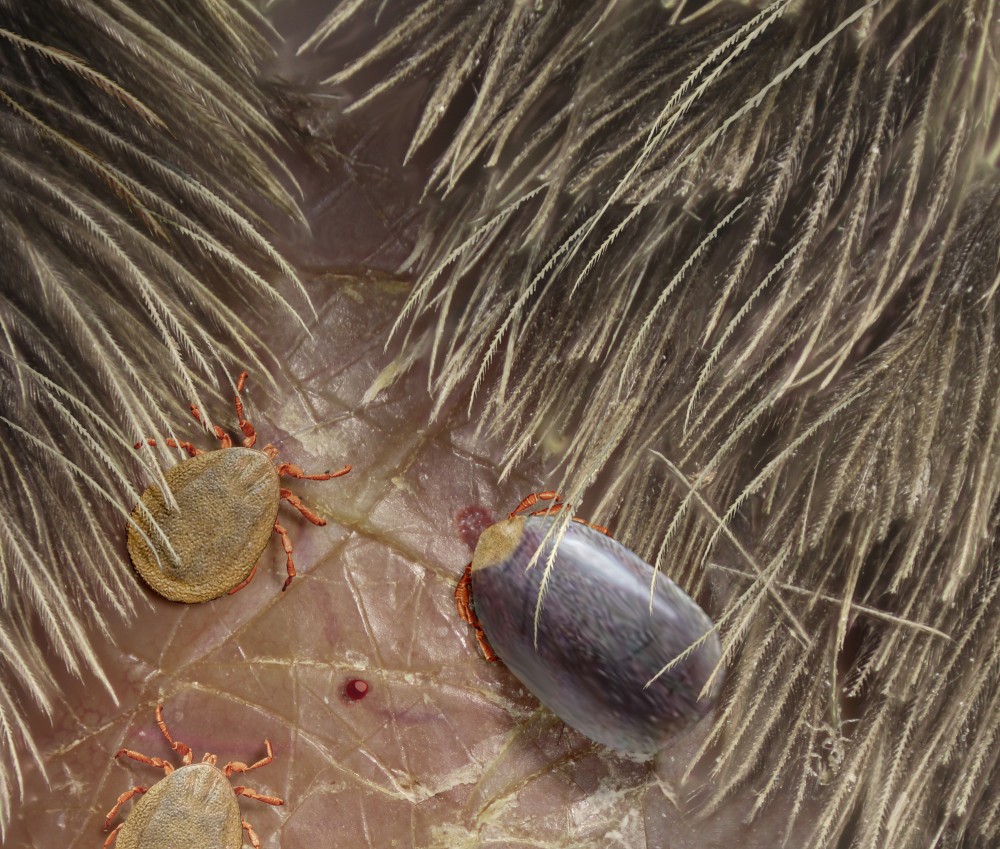Deinocroton Reconstruction on:
[Wikipedia]
[Google]
[Amazon]
''Deinocroton'' is an extinct genus of
 The strongly pitted surface of the body and large volume increase (8.5x) of engorged females suggests that the feeding behaviour was most similar to living soft bodied ticks and '' Nuttalliella,'' with a rapid engorgement time (minutes to hours), and multiple gonotrophic cycles. The preferred hosts have been inferred to be feathered dinosaurs, based on the association of known specimens with feathers in amber. The specimens were found associated with hastisetae, specialised hair of dermestid beetle larvae, which suggests that they inhabited nests.
The strongly pitted surface of the body and large volume increase (8.5x) of engorged females suggests that the feeding behaviour was most similar to living soft bodied ticks and '' Nuttalliella,'' with a rapid engorgement time (minutes to hours), and multiple gonotrophic cycles. The preferred hosts have been inferred to be feathered dinosaurs, based on the association of known specimens with feathers in amber. The specimens were found associated with hastisetae, specialised hair of dermestid beetle larvae, which suggests that they inhabited nests.
tick
Ticks (order Ixodida) are parasitic arachnids that are part of the mite superorder Parasitiformes. Adult ticks are approximately 3 to 5 mm in length depending on age, sex, species, and "fullness". Ticks are external parasites, living by ...
. It is known from two species found in Burmese amber, dating to the earliest part of the Cenomanian
The Cenomanian is, in the ICS' geological timescale, the oldest or earliest age of the Late Cretaceous Epoch or the lowest stage of the Upper Cretaceous Series. An age is a unit of geochronology; it is a unit of time; the stage is a unit in the s ...
stage of the Late Cretaceous, around 99 million years ago. Amongst the oldest ticks known, it is distinct from the main two living families of ticks, Ixodidae (hard bodied) and Argasidae (soft bodied), as well as '' Nuttalliella,'' and has been placed in the monotypic family Deinocrotonidae.
Taxonomy
Two species have been named, ''D. draculi'' and ''D. copia,'' both from Burmese amber, which dates to the late Albian-earlyCenomanian
The Cenomanian is, in the ICS' geological timescale, the oldest or earliest age of the Late Cretaceous Epoch or the lowest stage of the Upper Cretaceous Series. An age is a unit of geochronology; it is a unit of time; the stage is a unit in the s ...
stages of the Cretaceous period, around 100 million years ago.
Etymology
The name of the genus ''Deinocroton'' is composed of two words from the ancient Greek "deinos", "terrible", and "krotṓn", "krotṓn", "tick". The name of the species ''draculi'' refers to thevampire
A vampire is a mythical creature that subsists by feeding on the Vitalism, vital essence (generally in the form of blood) of the living. In European folklore, vampires are undead, undead creatures that often visited loved ones and caused mi ...
Count Dracula from the epistolary novel ''Dracula
''Dracula'' is a novel by Bram Stoker, published in 1897. As an epistolary novel, the narrative is related through letters, diary entries, and newspaper articles. It has no single protagonist, but opens with solicitor Jonathan Harker taking ...
'' by British writer Bram Stoker
Abraham Stoker (8 November 1847 – 20 April 1912) was an Irish author who is celebrated for his 1897 Gothic horror novel '' Dracula''. During his lifetime, he was better known as the personal assistant of actor Sir Henry Irving and busine ...
.
Description
''Deinocroton'' is distinguished from other ticks by a suite of characters relating to the structure of its integument, the morphology of the palps, and the preanal groove shape. The surface of the body is densely pitted with deep pits, and eyes are absent.Ecology
 The strongly pitted surface of the body and large volume increase (8.5x) of engorged females suggests that the feeding behaviour was most similar to living soft bodied ticks and '' Nuttalliella,'' with a rapid engorgement time (minutes to hours), and multiple gonotrophic cycles. The preferred hosts have been inferred to be feathered dinosaurs, based on the association of known specimens with feathers in amber. The specimens were found associated with hastisetae, specialised hair of dermestid beetle larvae, which suggests that they inhabited nests.
The strongly pitted surface of the body and large volume increase (8.5x) of engorged females suggests that the feeding behaviour was most similar to living soft bodied ticks and '' Nuttalliella,'' with a rapid engorgement time (minutes to hours), and multiple gonotrophic cycles. The preferred hosts have been inferred to be feathered dinosaurs, based on the association of known specimens with feathers in amber. The specimens were found associated with hastisetae, specialised hair of dermestid beetle larvae, which suggests that they inhabited nests.
Relationships
The initial describing paper assumed a sister relationship with '' Nuttalliella,'' based on several apparently shared characters, though this was in absence of cladistic analysis.References
{{Taxonbar, from=Q50177259 Cretaceous insects of Asia Ticks Burmese amber